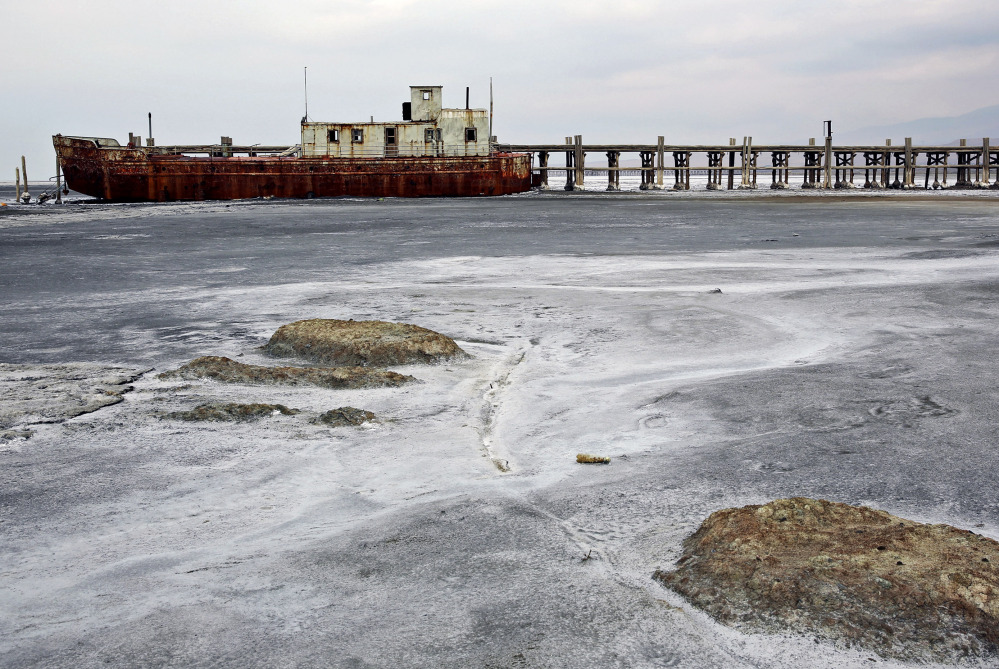OROUMIEH, Iran — The first Cabinet decision made under Iran’s new president, Hassan Rouhani, wasn’t about how to resolve his country’s nuclear dispute with world powers. It was about how to keep the nation’s largest lake from disappearing.
Lake Oroumieh, one of the biggest saltwater lakes on Earth, has shrunk more than 80 percent to about 400 square miles in the past decade mainly because of climate change, expanded irrigation for surrounding farms and the damming of rivers that feed the body of water, experts say. Salt-covered rocks that were once deep underwater now sit in the middle of desert.
Experts fear the lake – famous in years past as a tourist spot and a favorite stopping point for migrating flamingos, pelicans and gulls – could disappear within two years if nothing is done.
“The lake is gone. My job is gone. My children are gone. Tourists, too,” said Mozafar Cheraghi, 58, as he stood on a dusty platform that was once his bustling teahouse.
Less than a decade ago, he recalled, he hosted dozens of tourists a day, with his two sons taking them on boat tours. His children have since left to pursue work elsewhere.
“I sold a dozen boats and kept half a dozen here, hoping the water will return,” he said. “But it didn’t happen.”
Rescuing the lake in northwestern Iran, near the Turkish border, was one of Rouhani’s campaign promises, and his new Cabinet promptly decided to form a team to invite scholars to help find solutions.
The president is putting an emphasis on tackling long-neglected environmental problems critics say were made worse by his predecessor, Mahmoud Ahmadinejad. An engineer with an appetite for giant populist projects, Ahmadinejad pursued policies that led to the expansion of irrigation projects and construction of dams.
“Rouhani stands by his campaign promise to revive the lake,” Isa Kalantari, a popular scholar appointed by Rouhani to lead the rescue team, said at a conference in Oroumieh this week.
The new administration in Tehran is seeking input on the lake beyond Iran’s borders, raising at least the possibility for further avenues of dialogue at a time when Iran is showing a greater willingness to engage with the West.
This week’s gathering included a number of foreign experts in addition to the Iranian scientists charged with trying to reverse the trend at Oroumieh and saving Iran from a major environmental and economic disaster. Authorities said those advising Iranian scientists on the project included representatives from the United States, Russia and Belgium.
“Don’t blame nature and drought. Human beings, not climate change, are responsible for this situation. We dried up the lake because of our excessive demands and wrong methods. Now, we have to revive it ourselves. Five million people have to leave this region if the lake dies,” Kalantari said.
Kalantari and his team are to come up with a final rescue plan by May.
Twenty proposals are on the table for saving the lake, including cloud-seeding to increase rainfall in the area and the building of pipelines to bring in more water. Experts have also proposed the creation of other industries to reduce reliance on agricultural water.
The government has already begun a project to raise public awareness and encourage farmers to abandon wasteful practices and adopt drip irrigation systems that save water. It is also urging farmers to switch to less-thirsty crops. Wheat and pistachios, for example, use less water than sugar beets.
In the village of Govarchinghaleh, near the lake, Nader Hazrati and his son, Ali, grow grapes and almonds.
“A decade ago, this was a green area. Now it is not because of decrease in rainfall. With the level of water in the lake going down, water in wells has gone down too. If we dig deeper, the water gets very salty and isn’t fit even for agricultural use. Our grape and almond harvest has fallen dramatically,” Ali said.
Ali, 27, said salty winds have killed some of his almond trees.
The effect on crops has prompted many villagers to leave the place of their birth. Govarchinghaleh had about 1,000 people a decade ago. Now, only 300 live in the village overlooking the shrinking lake. Once there were three schools; now there is one, serving a dozen students.
Not far away, trucks hauling salt, a new business, could be seen driving over the dry lake bottom.
Lakes in other parts of Iran are facing a similar crisis, though not as severe as at Oroumieh.
Copy the Story LinkSend questions/comments to the editors.



Success. Please wait for the page to reload. If the page does not reload within 5 seconds, please refresh the page.
Enter your email and password to access comments.
Hi, to comment on stories you must . This profile is in addition to your subscription and website login.
Already have a commenting profile? .
Invalid username/password.
Please check your email to confirm and complete your registration.
Only subscribers are eligible to post comments. Please subscribe or login first for digital access. Here’s why.
Use the form below to reset your password. When you've submitted your account email, we will send an email with a reset code.